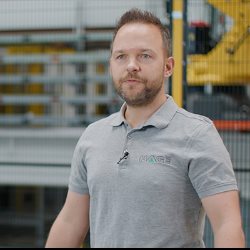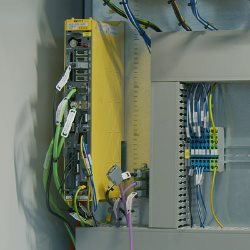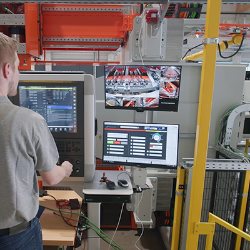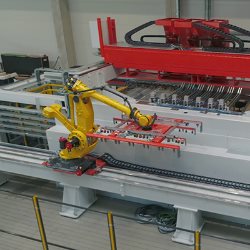Creating an automated multi-spindle, multi-axis friction stir welding machine in less than a year is far from straightforward. And yet that was the goal for HAGE as it sought to meet the requirements of an important customer, a manufacturer of battery trays for electric vehicles. Due to the complexity of the required system, one of the dilemmas was switching away from the company’s long-standing control system.
 “We definitely entered new territory with FANUC,” states HAGE Technical Director Peter Freigassner-Sanchez. “The decision to go with FANUC was difficult, yet the swift progress of the project clearly showed it was the right choice. FANUC impressed us from start to finish, meeting our short delivery times with full project support in all directions. The machine is a masterpiece of engineering. An absolute challenge in every respect.”
“We definitely entered new territory with FANUC,” states HAGE Technical Director Peter Freigassner-Sanchez. “The decision to go with FANUC was difficult, yet the swift progress of the project clearly showed it was the right choice. FANUC impressed us from start to finish, meeting our short delivery times with full project support in all directions. The machine is a masterpiece of engineering. An absolute challenge in every respect.”
 Close co-operation between FANUC Austria and HAGE led to the specification of the FANUC
30i-B Plus controller and FANUC M-900iB/330L robot for the full automation of the friction stir welding system. The machine offers six-spindle synchronisation with precise, multi-axis control. As a point of note, the FANUC robot mounts on a linear axis, thus providing a seventh axis as it traverses along the full length of the system.
Close co-operation between FANUC Austria and HAGE led to the specification of the FANUC
30i-B Plus controller and FANUC M-900iB/330L robot for the full automation of the friction stir welding system. The machine offers six-spindle synchronisation with precise, multi-axis control. As a point of note, the FANUC robot mounts on a linear axis, thus providing a seventh axis as it traverses along the full length of the system.
 “The machine’s innovation is its highly automated and fast manufacturing capability, supported by the fast torque control of the FANUC CNC,” explains HAGE Project Manager Tobias Pirker. “Right from the outset of adopting this technology we had an extremely positive feeling, benefitting from the advice provided by the key account manager and many technicians at FANUC Austria.”
“The machine’s innovation is its highly automated and fast manufacturing capability, supported by the fast torque control of the FANUC CNC,” explains HAGE Project Manager Tobias Pirker. “Right from the outset of adopting this technology we had an extremely positive feeling, benefitting from the advice provided by the key account manager and many technicians at FANUC Austria.”
 HAGE Electrical Engineer Christina Buchmann also praises the support available: “FANUC is a new manufacturer for us, which is why I was very impressed with their fantastic support. They had an immediate answer to every question. FANUC were particularly helpful in the creation of macros that I needed in my E-plan. No macros were available for certain devices in the control cabinet, so FANUC created them especially.”
HAGE Electrical Engineer Christina Buchmann also praises the support available: “FANUC is a new manufacturer for us, which is why I was very impressed with their fantastic support. They had an immediate answer to every question. FANUC were particularly helpful in the creation of macros that I needed in my E-plan. No macros were available for certain devices in the control cabinet, so FANUC created them especially.”
FANUC also delivered a comprehensive training course to help HAGE personnel get up to speed on both the 30i-B Plus controller and M-900iB/330L industrial robot.
Working in close liaison from start to finish, HAGE and FANUC managed to achieve project implementation in just 10 months, a remarkable feat not lost on Freigassner-Sanchez: “We are very enthusiastic about using FANUC for our future special-purpose machines.”